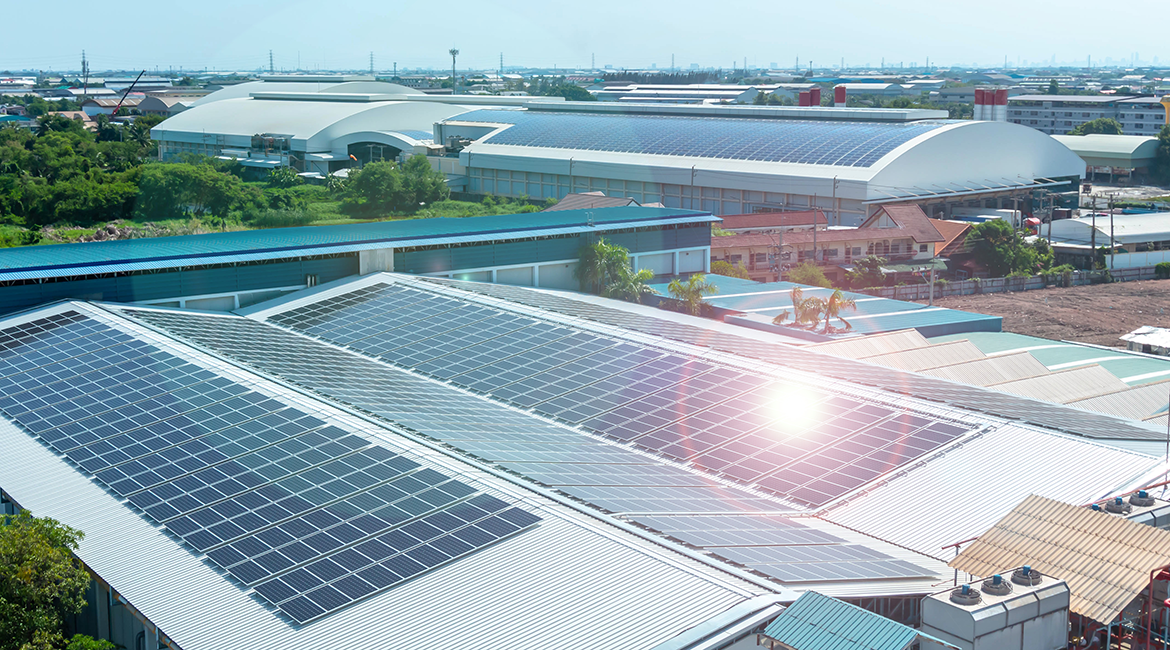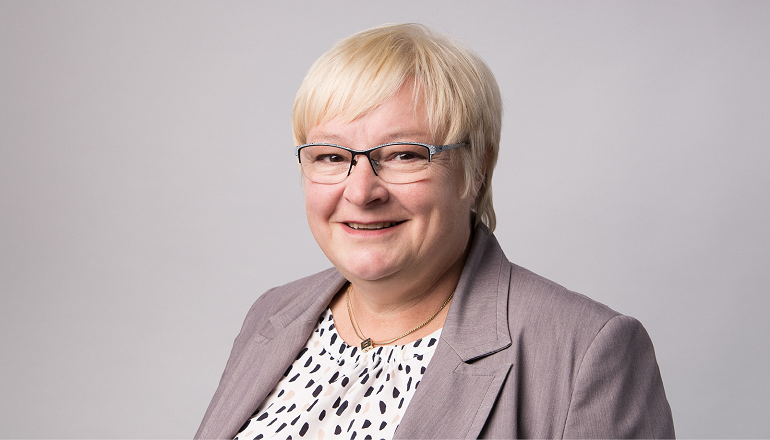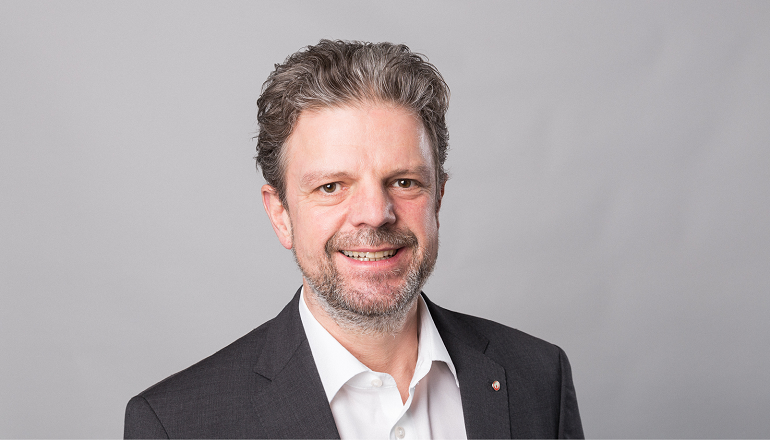Take action now to save energy costs in the long term
Renewable energy: seizing opportunities for integration

On the path to climate neutrality, renewable energies are an important component for companies. Against the backdrop of the EEG amendment and rising electricity and gas prices, it is worthwhile to take a comprehensive look at investments in renewable energy sources for electricity and heat generation and to kick-off the planning process.
Generate electricity with renewable energies
Companies can reduce their electricity costs and emissions by reducing their electricity consumption, for example through increased energy efficiency. Another important pillar in a climate strategy is to replace fossil fuels for heat and power generation with renewable energies. Companies are even independent of current market price developments and the availability of energy when using their own plants as a source of electricity.
ÖKOTEC experts still see some potential for industrial and commercial companies, as the current share of renewable energy generation at sites is rather low. However, depending on the size of the site and the demand, it is estimated that up to 30 percent of the electricity demand can be covered by photovoltaics (PV). A combination of PV, wind turbine and electricity storage could even enable up to 60 percent under suitable conditions.
Leading Consultant
Sylvia Jacobi
“Many companies are looking for short-term measures due to the current energy crisis. Our experience shows that major savings are only possible through a holistic approach and strategic planning.”

How can companies integrate renewable energies into their processes?
The basis for investment planning is always a comprehensive site and demand concept that is tailored to the company’s production processes and location. This includes, for example, comprehensive planning of land use (solar thermal vs. photovoltaics) and an assessment of whether and to what extent electricity or heat should be generated. To reach the target of CO2 neutrality, a combination of energy efficiency, heat recovery, use of renewable energies and the electrification of processes is the best way forward for companies. In the following, we present the most important renewable energy sources for power and heat generation.
Wind energy – detailed examination of small wind turbines
Wind energy is a growth industry in Germany. Rotors convert the kinetic energy of the wind into mechanical rotational energy in the first step, and a generator converts this into electrical energy. To generate a high electricity yield, high average wind speeds and the size of the rotor surface are crucial. While turbines up to 10 meters in height do not require a permit, approval procedures for large wind turbines are often complex and lengthy.
Small wind turbines are compatible with an urban environment and smaller open areas. However, the purchase and maintenance costs are very high in relation to the amount of electricity produced. Meanwhile, less expensive models can be found on the market and are also available online. Before taking a purchasing decision, we recommend that you carefully check the quality and expected runtime. Due to the high market demand, we expect a steady further development of the modules in the near future.
The option of a power purchase agreement (PPA) can be particularly important for larger wind farms. Power generators enter into direct, long-term contracts with power purchasers for PPAs.
Advice on the initiation, negotiation and drafting of these contracts provides guidance in this complex and dynamic subject area, particularly in the context of the current price volatility.
Photovoltaics – better economic efficiency due to lower investment costs
In photovoltaic systems, monocrystalline or polycrystalline solar cells convert the sun’s radiation into electrical energy. The solar yield of plants is strongly dependent on their location. While in the past a southern orientation and an incline of 30 percent were adhered to, people are now moving towards accepting a slightly reduced efficiency in exchange for using as much (roof) area as possible. The economic efficiency of new systems has improved steadily in recent years due to falling investment costs.

Consultant Energy Markets
André Presser
“For the evaluation of photovoltaics, we combine our technical experience with the data intelligence of our EnEffCo® software. In a compact analysis, we determine the potentials and self-consumption shares based on the transmitted load profiles. The result can be used directly for the investment application.”
In principal, there are the options of a full feed-in to the electricity grid, a partial feed-in, own use only, and a combination of the last two. Areas can also be subdivided to achieve a mix of feed-in tariffs. As part of the EEG amendment, feed-in tariffs at which energy producers can release excess electricity into the grid have been adjusted and made more attractive. The feed-in tariff is based on the price at the time of putting the system into operation and then remains the same. For new plants, it must be considered whether an investment in a storage system is profitable in order to enable self-use even in less favorable weather conditions.
PV can also be particularly attractive to businesses that have high electricity demand during the summer months, such as the food and nutrition industries.
Companies should seek advice from experts as early as the planning phase in order to make optimum use of the existing space in the long term. We also recommend that these measures be initiated at an early stage, as the availability of systems, components and planning and installation companies is currently limited.
Heat generation from renewable energies
Heat generation accounts for 50 percent of total German final energy consumption. The shares of energy sources have changed only imperceptibly in recent years, even though renewable energy sources are increasingly coming into focus. (UBA 2022)
Heat pumps – key technology for decarbonization
Heat pumps enable the electrification of heat generation and are a key technology for companies when it comes to decarbonization and substituting natural gas and oil.
Heat sources can be either earth, air or water, with waste heat being used specifically as a heat source, for example in the form of waste water and exhaust air . We expect significant development leaps for heat pumps over the next few years, such as improvements in efficiency, i.e. the ratio between the heat provided and the electricity used.
Basically, a distinction is made between conventional and high-temperature heat pumps, depending on their use. For industries where there is a simultaneous demand for heating and cooling, heat pumps could be an efficient alternative to conventional heating and cooling systems. To ensure that heat pumps are indeed an environmentally friendly investment, companies should check the expected energy efficiency of the systems and purchase only green electricity or generate the energy required themselves.
Solar thermal – heat for water and heating
Solar thermal systems convert sunlight into heat and are used mainly for heating water. The use of solar thermal systems is strongly dependent on the seasonal usage profile of the company and the storage possibilities for the generated heat. Hospitals or hotels are currently successful practical examples, as they require relatively large quantities of hot water in summer. However, the use of solar thermal energy could also be a sensible option for companies that have integrated washing processes into their production processes.
Here, too, the modules on offer differ in terms of acquisition costs and efficiency depending on the design and, like all investments in renewable energies, should be subjected to a profitability analysis. As with heat pumps, the higher the required temperature, the lower the efficiency of the collectors. Therefore, solar thermal systems should be used in combination with lower temperature applications. In terms of alternative land use, PV systems or a combination of PV system and heat pumps potentially compete with solar thermal modules. Careful consideration of the respective advantages and disadvantages is a component of the supply concept to be developed.
Geothermal energy – near-surface geothermal energy accessible
Geothermal energy uses the heat energy stored in the earth. Geothermal energy is divided into near-surface (up to 400 m) and deep geothermal energy. The decisive advantage is the technology’s independence from weather conditions, as well as only limited and controllable effects on the environment. Near-surface geothermal energy is possible in many places in Germany. However, near-surface layers have a relatively low temperature level and therefore may require coupling with a heat pump. Geothermal energy uses ground collectors, ground probes and open systems with seepage and suction wells. The necessary drilling and civil engineering work are the primary cost drivers in geothermal energy. Among other things, the expected temperatures and thus the probability of freezing at the respective depth of the ground must be taken into account during planning, and these must be weighed against the costs of deeper boreholes. Furthermore, according to VDI Guideline 4640, temperature changes compared to undisturbed ground temperature must not exceed 11 Kelvin in order to ensure a sustainable regeneration of the ground.
Are you planning to invest in renewable energies? We develop a sustainable concept together with you.
The acquisition and integration of renewable energies requires the development of a holistic and future-oriented supply strategy. Here, we take into account the individual requirements from the project and the conditions on site.
In addition to the conception of measures, we also support you with our expertise in the examination of potential subsidy programs, such as Module 2, process heat from renewable energies, from the federal subsidy for energy and resource efficiency in the economy. The maximum subsidy for the replacement or new acquisition of plants for the provision of process heat is 15 million euros per investment project, with a subsidy rate of 45 percent (or 55 percent for SMEs) of the eligible investment costs (as of October 25, 2022).
More information
- Measures to increase energy efficiency and natural gas substitution
- ÖKOTEC Windenergie: Consulting from search area procedure to approval planning (Website only available in German)






